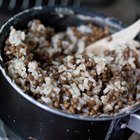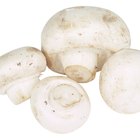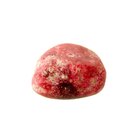With over 120 varieties, the small number of quinoa types available for sale in the United States might surprise you. The varieties of quinoa most widely available are distinguished by their color -- white, red or black. Quinoa is a grain-like seed that originates from the Andes in South America but is now available for sale in grocery and health food stores. The seed is loved for its slightly crunchy and chewy texture, nutty taste and high nutritional value. Red and white quinoa have some slight differences in taste and texture, but in general, one can be used in place of the other.
Color and Appearance
The most obvious difference between red and white quinoa is the color. Red quinoa is a ruddy, brick red color -- cooked and uncooked. White quinoa, on the other hand, is more of a beige color and is also sometimes called golden, yellow or ivory quinoa.
With both red and white quinoa, the seeds keep their round shape after cooking, and a thin “tail” is visible around the circumference of the seed. White quinoa is the most widely available of the two, although red quinoa is increasingly found on grocery store shelves.
Many cooks choose the type of quinoa based on appearance alone. Red quinoa showcases the dark color of green vegetables and cooked white fish well. White quinoa, in turn, is ideal for giving a dish a summery, light appearance and for offsetting bright colored foods, such as fresh tomatoes or broiled salmon.
Taste
Quinoa has a very mild, nutty, earthy taste when cooked. Red quinoa, because it is a different variety, is slightly nuttier tasting than white quinoa, although this difference is not very pronounced. While the difference in taste is almost negligible, the extra nuttiness of red quinoa means it may be better suited for sauced dishes, such as meat stews. White quinoa may be better suited for dishes where a milder taste is needed, such as a quinoa salad with fresh vegetables.
Texture
Both red and white quinoa maintain a slight crunch after cooking. Red quinoa has a bit more bite than white quinoa. Because red quinoa has more crunch when cooked, it also maintains its shape better than white quinoa. This is especially true for soupy dishes, such as sopa de quinoa, a traditional South American soup that uses chilies for seasoning and quinoa to make it filling.
Cooking
Red quinoa takes a bit longer than white to fully cook. White quinoa is finished cooking in roughly 10 to 15 minutes. Red quinoa requires two to three minutes more cooking time to be ready.
While commercial retailers for quinoa wash the seeds before selling them, both red and white quinoa benefit from rinsing before cooking. Rinsing removes the saponins on the seeds, a natural coating that gives the seed a bitter taste when cooked.
To cook red or white quinoa:
Combine 1 cup of quinoa to 2 cups of liquid.
Bring the quinoa to a rapid boil on high heat, then reduce the heat to medium, and cook it at a simmer for 10 to 20 minutes, until the quinoa is done.
Red and white quinoa are ready to eat when the center of each grain is soft and toothsome and a thin tail is visible around the edge of each seed.
Cooking Tips
Rinsing quinoa is only necessary if you want to remove all traces of bitter saponins from the seeds. Otherwise, the slight bitterness of the grain is often masked by dressings, sauces and other ingredients.
Cook dried quinoa in meat or vegetable broth, with a 1/4 teaspoon of salt per cup of quinoa to enhance the taste.
Add dried spices to the quinoa before bringing it to a boil. Dried oregano, basil or thyme enhances quinoa’s naturally earthy taste, while chili flakes and garlic and onion powder give the grains an almost meaty richness.
Quinoa can be safely cooked in a slow cooker or in a rice cooker. Use a 1/4 cup less water when cooking with these methods, as the longer cooking times means the grains require less liquid.
Related Articles

Difference Between Red Rice & Brown Rice

Cubic Zirconia Vs. White Spinel

White Vs. Yellow Popcorn

How to Cook With Kamut

Herbs & Spices in Lentil Soup

How to Store Quinoa
How to Roast Quinoa for a Nuttier Flavor

Rice & Lentil Diet
How to Substitute Quinoa for Breadcrumbs

How Does Measuring Dry Quinoa Compare ...

Portobello Mushroom Vs. Button Mushroom
Can I Grind Quinoa?

Can You Mix Quinoa & Brown Rice in a ...

How to Identify Red Jasper

How to Cook Red Camargue Rice

Differences Between Steamed & Boiled ...

The Weight of Raw Lentils to Cooked ...

Hard White Wheat Vs. Hard Red Wheat

How to Cook Quinoa Pasta

How to Cook Bulgar Wheat in the ...
Writer Bio
Cynthia Au has studied at the Cordon Bleu in Paris and currently works as a chef instructor specializing in food styling. She has worked as a writer and editor with a focus on food and food science since 2007 and regularly teaches both adults and young children about the joys of home cooking.